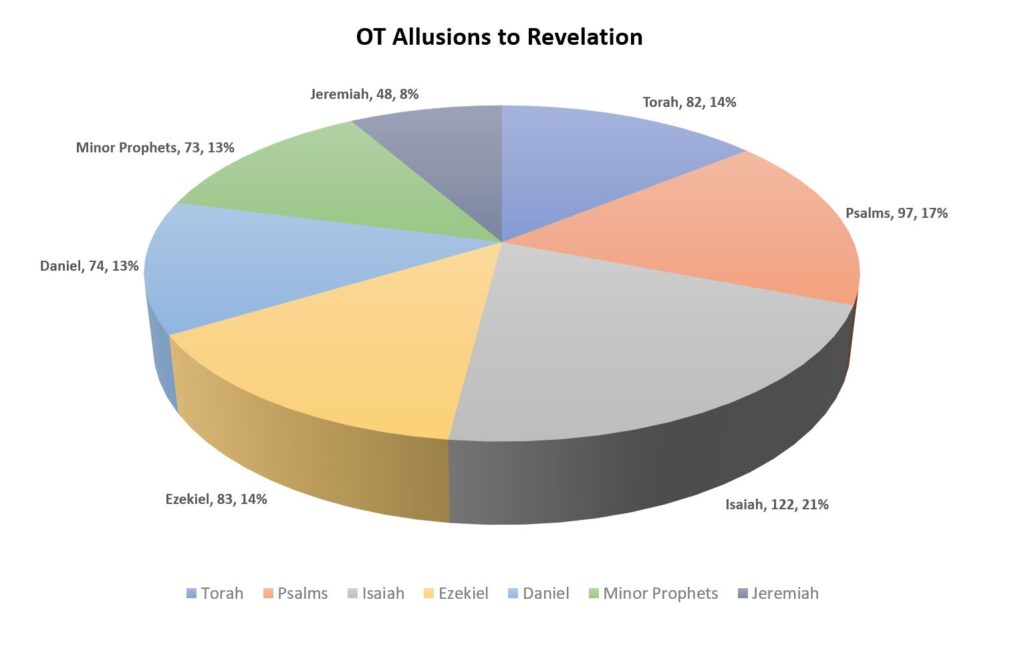Thesis: The OT in the book of Revelation and John’s use of corresponding apocalyptic work in the book of Revelation. The following are presentation notes concerning the literary nature of the book of Revelation, not its eschatological intent.
The Old Testament in the Book of Revelation
The following is a look at second temple Jewish literature and OT material from the intertestamental period. The source material is the Hebrew Bible (the OT), Jews studying the OT of the same period, world, and cultural setting all current with John of Revelation. The Book of Revelation never uses an introductory formula to introduce OT references. John uses words and phrases from the OT into Revelation’s composition. John draws upon these words and phrases, not as quotes but as material to produce his content. The index of allusions and quotations in the Greek NT reveals that the book of Revelation contains more OT allusions than any other NT book. Yet, there is not a single quotation in the NT that references back to the OT.
John used bits and pieces to create his composition. His voice plus the phrases of meaning from the OT. It is, therefore, useful to understand what sources and OT passages that John was using. Was John using the MT or the LXX? Or both? What was the source text he used? Can the MT or LXX support or sustain what the author concludes? Was the author faithful to what the MT or the LXX says?
In the hindsight of Revelation, does John’s use of the OT articulate Jesus-influenced theology messianic interpretation that could have been obtained by using the MT or LXX prior to the first advent of Christ? Can John (or the reader of Revelation) still discern possible messianic interpretations obtained from the OT even before the Messiah arrived? If he can, then his use of the OT to produce the content of his apocalyptic work is legitimate.
John interprets the Old Testament in light of his experience with Jesus.
Ancient first-century approaches to the Bible should be included in hermeneutical methodologies. Old Testament content is repurposed and is legitimate.
John’s preference for literature was the prophets and poetic works (worship literature).
The Use of Daniel in Jewish Apocalyptic Literature and the Revelation of St. John
Three decades after DSS discoveries. Beale writes of John’s use of the Old Testament by categorizing his use of ancient scripture.
Categories & Methods of Interpretation
- Segmentation: Segments of the OT are used as literary prototypes. John models his material after patterns he sees in the OT. He follows sequence or structure to build his content. Or “clusters” of allusions in the OT to use them in sections of Revelation. Reference Daniel 2 and 7 as examples from Revelation 13 and 17.
- Thematic: The thematic use of the OT. The divine warrior, earthly cataclysm, eclipses, etc., are directed to apocalyptic messaging in the Revelation to produce content.
- Analogical: The analogical use of the OT is used to repurpose well-known persons, places, and events to produce or illustrate imagery by analogy. Such as the Exodus plagues (Rev 8:6-12; the seven trumpets, Rev 16:2-13; the seven bowls) to illustrate the analogical use of the OT.
- Universal: The universalization of OT application of what occurred to Israel to the rest of the world. The “Kingdom of Priests” principle concerning the Hebrews became applied to the Church (e.g., Rev 5:9-10). Material meant for Israel becomes universally applied to the Gentiles.
- Informality: Informal direct prophetic fulfillment where John, the author of Revelation, sees the fulfillment of OT passages in Jesus or His return by implication and inference. For example, the allusion of Zechariah 12:10 concerns Rev 1:7, where “those whom they have pierced” is not a word-for-word reference but by palpable and undeniable inference around messianic fulfillment.
- Typological: A non-verbal prophecy or foreshadowing of something to come. Present within the literature are synonyms that bear the concept of resemblance and similarity. A general definition identifies a biblical event, person, or institution that serves as an example or pattern for other events, persons, or institutions (Baker). Typological relationships exist between events, persons, or institutions that, through divine inspiration, foreshadow later patterns or specific events and conditions that happen later within salvation history. New Testament writers use typologies. —Compare Isaiah 22:22 with Rev 3:7b concerning the key of David as a foreshadow to the keys of Death and Hades (Rev 1:18). These two are linked together; the inference is that Jesus holds power over salvation and judgment since it comes through the line of David. David foreshadowed another king to come: Jesus. As a typology, John uses David as a foreshadow of Jesus in his messianic kingship, who has control over a kingdom.
- Inversion: Some allusions are contradictory to the OT contextual meaning, but it’s a surface observation. Upon closer inspection, this category does not work. To see John is doing something subtle and unique. For example, some passages in Isaiah show Gentiles bowing down before Israel to recognize their elect status before YHWH (Isaiah 45:14, Isaiah 49:23, compared to Revelation 3:9). Revelation 3:9 inverts the imagery to concern the Church as to the Jews of Israel.
- Style: The perceived imprecise use of the Greek language involved solecisms (grammatical mistakes) throughout the Revelation. John intentionally used Greek “errors” in the language to express his Semitic mind more precisely. They were deliberate efforts to intentionally say something specific in the way it is expressed in Hebrew. Solecisms are littered throughout the Revelation to make the reader look and understand what is occurring from the OT.
______________________
Michael Heiser, “Introducing The Old Testament in the Book of Revelation” (podcast), December 1st, 2020, accessed April 23rd, 2021, https://nakedbiblepodcast.com/podcast/naked-bible-352-introducing-the-old-testament-in-the-book-of-revelation/
G.K. Beale, “The Use of Daniel in Jewish Apocalyptic Literature and in the Revelation of St. John” (Eugene, OR: Wipf and Stock Publishers, 2010)
Steve Moyise, “The Old Testament in the Book of Revelation”, The Library of New Testament Studies, (London, UK: T&T Clark Publishing, 2014)













